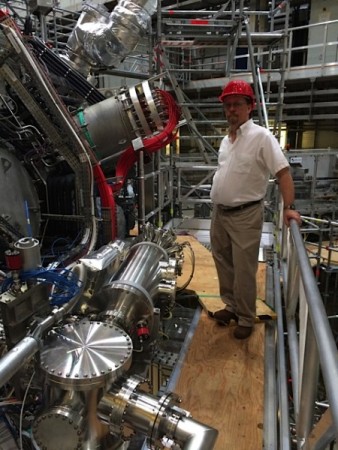Feb 3 2016
Scientists at the U.S. Department of Energy’s Princeton Plasma Physics Laboratory (PPPL), who collaborate with the Max Planck Institute in Germany on the Wendelstein 7-X (W7-X) fusion energy reactor, congratulated the team for starting its scientific investigations on fusion energy by producing its first hydrogen plasma on Feb. 3. Hydrogen will provide the fuel necessary to create the energy in an eventual power plant.
 Photo by Hans-Stephan Bosch.David Gates, the stellarator physics leader at PPPL by the completed X-Ray crystal spectrometer on the W7-X in October.
Photo by Hans-Stephan Bosch.David Gates, the stellarator physics leader at PPPL by the completed X-Ray crystal spectrometer on the W7-X in October.
“We’re delighted that W7-X is online,” said Stewart Prager, director of the PPPL. “This truly is a significant achievement. It is a unique experiment in the world, the largest and most advanced fusion stellarator design in the world.”
Prager said that the data from the W7-X will help inform the roadmap to achieving fusion power plants. “This is a frontier experiment entering new terrain in an area that’s never been looked at before. It should be immensely useful.”
Hutch Neilson, head of Advanced Projects at PPPL and the coordinator of the U.S. collaboration, was at the fusion reactor for the event along with PPPL physicists Sam Lazerson and Novimir Pablant, and Princeton University Vice President for PPPL Stewart Smith, as well as Ed Synakowski, DOE Associate Director of Science for Fusion Energy Sciences. German Chancellor Angela Merkel was an invited guest. “This is extremely important and we are fortunate to be a part of it,” Neilson said. “They are a wonderful partner.”
David Gates, a PPPL physicist and stellarators physics leader, was equally enthusiastic. “We’re talking about creating a state that’s never been created on Earth,” he said of fusion energy. “We are all really looking forward to these results, and it’s very exciting to bring this machine online.”
The W7-X is a stellarator - the largest and most advanced fusion experiment of its kind in the world. It uses twisting magnetic coils to confine a superhot gas called a plasma in a steady state for up to 30 minutes. The ultimate objective: develop a power plant that produces energy from the fusion of light atomic nuclei, as does the sun. The W7-X experiment will investigate whether it is a suitable configuration for such a power plant.
PPPL built some key components for the experiment and leads the U.S. collaboration with W7-X. Among the contributions of the U.S. collaboration:
- Designed and delivered five massive 2,400-pound trim coils that fine-tune the shape of the plasma
- Designed and built an X-ray crystal spectrometer for diagnostic imaging
- Designed and is building divertor scraper units that intercept heat from the plasma to protect divertor targets from damage
The U.S. effort is funded by $4 million annually from the Department of Energy’s Office of Fusion Energy Sciences. Collaborators include researchers from Los Alamos and Oak Ridge National Laboratories, as well as researchers and students from MIT, the University of Wisconsin, Auburn University, and Xantho Technologies, LLC.